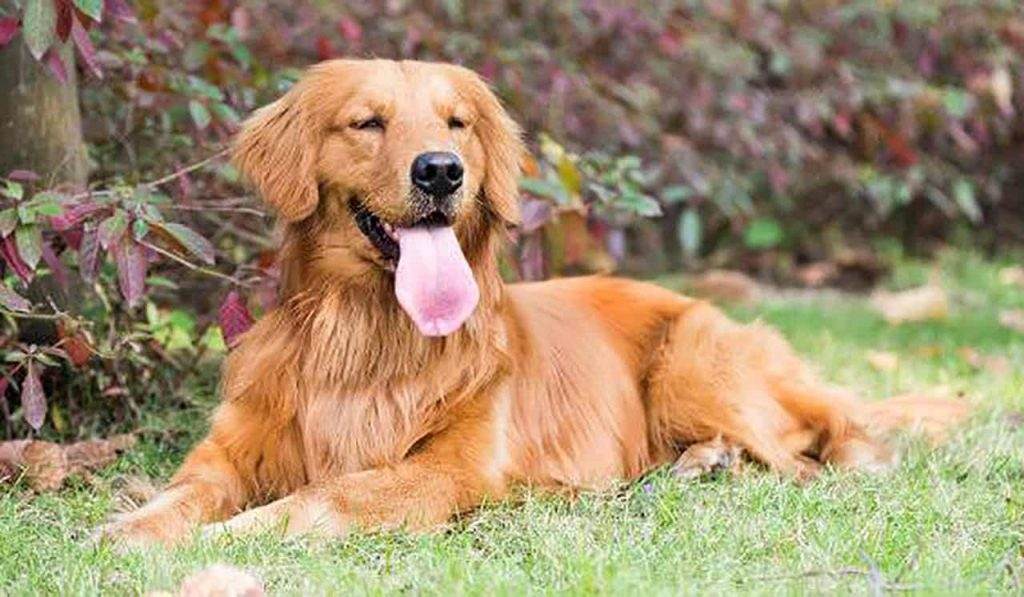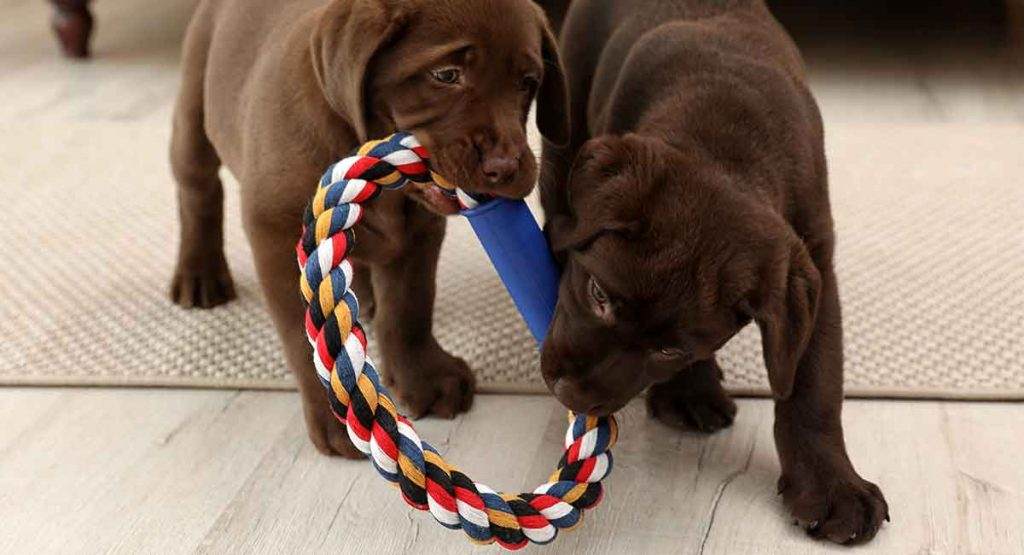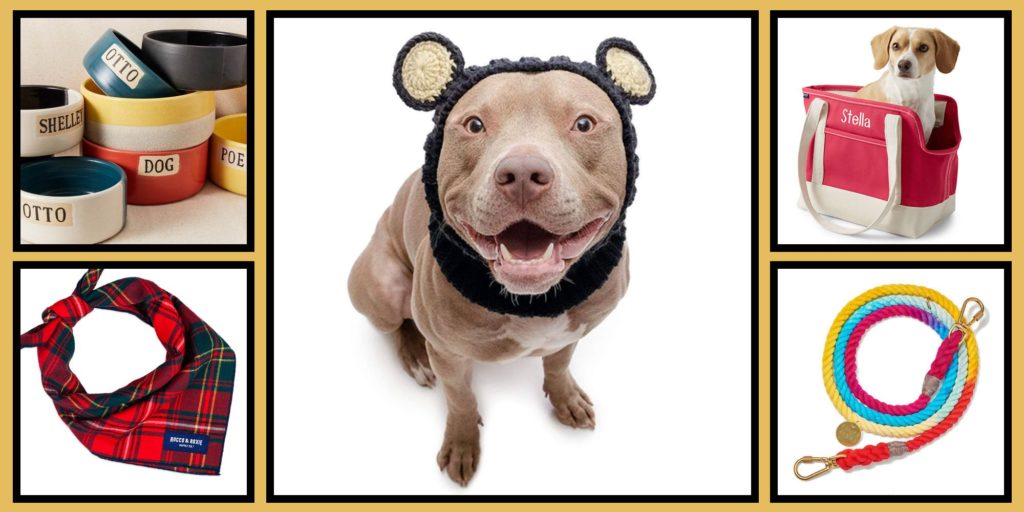Most welcome to a full guide of Mini Labradoodle. This breed is the small size Labradoodle, it is actually a ‘Poodle labradoodle retriever’. We all know about the labradoodle mix but most of us don’t know about this miniature, lovable, designer dog breed. This Mini Labradoodle breed gets its size by breeding with a miniature poodle.
If you get the smaller labradoodle, that you get all the same traits, qualities of normal size labrador in a very smaller pack. Also, The Mini Labradoodles are of two types: Mini Labradoodle and the Mini Australian Labradoodle. These both are called Toy Labradoodle.
The Mini Labradoodle is only the result of breeding with a miniature poodle. However, the Mini Australian Labradoodle was may be the result of breeding from any of these; English Cocker Spaniel, Irish Water Spaniel, and American Cocker Spaniel lineage.
The physical appearance of Mini labradoodle depends on the parents. Their coats come in a wide range of colors, textures, and lengths.
As said above, mini Labradoodles have the same traits as of the normal size but it is small in size.
About the Mini Labradoodle Breed
It is a very popular designer dog breed since 1917 (it was discovered). Its weight is about 15 to 30 pounds. This is very friendly whether it is the normal size Labradoodle or Mini Labradoodle. This breed also very affectionate and smart. This breed is originally bred to be a pet dog, a service dog/therapy. For further details read the whole guide, here you will get everything you wanna know.
In this guide, you will know vast information about the breed. And also, what makes Mini Labradoodle unique from the other pet dogs. We will further talk about its traits, behavior, also the history of this breed. So, stay with us for more details.
How Mini Labradoodle Originated?
This breed comes from Newfoundland, Canada. These were the small water hunting dogs, later they were bred into, nowadays the ‘Labrador Retriever’.
At first AKC (American Kennel Club) realize this breed as a part of the sporting breed in 1917. Still, the Labradors are used as hunting dogs. Also, they can be seen in homes as a pet and as a service dog.
How Miniature Poodle Originated?
This breed comes from Germany. In Germany, the ‘Pudels’ were used as waterfowl retrievers. When it eventually comes to the United States, in 1887 the AKC realize it as a non-sporting breed.
This breed always pictured as a luxurious dog, sitting on a couch or cushion with his rich owner. They think that this breed is only seen in the show ring. However, this dog has very high energy, it is also a very trainable breed. It is not less than the Labradoodle.
There are also some fun facts about Labradoodles,
The Labradoodle is owned by most celebrities like from politician Joe Biden to actress Jennifer Aniston. Also, the Mini Labradoodle gained so much popularity in stars.
What can you expect from a Mini Labradoodles?
A mixed-breed dog is a bundle of surprise. It is impossible to fully predict which trait your dog will inherit from his parent dogs. You will see multiple surprises while your dog is in his growing stage, till he gets matured.
Mini Labradoodle is a mixed breed so you cannot be completely sure about their temperament, physical appearance, inherited disease, or any allergen sensitivity that they may have.
Now lets go through the Mini Labradoodles characteristics point wise.
Characteristics of Mini Labradoodles are:
Appearance of the Mini Labradoodle
Most people wonder that if there is an adult Mini Labradoodle, so the size of it be medium in size like its Labrador parent, or small like its parent Miniature poodle.
Talking about the size of the Labrador and Toy Poodle. The Labrador can reach up to 24 inches tall to the shoulders if they get the size of its parent Labrador. And the size of a Toy Poodle is 14 to 16 inches tall if they get the size of its parent Toy poodle.
The Mini Labradoodle weighs between 15 to 25 pounds. This is due to their parent body sizes. The Mini Labradoodle is a hybrid of two breeds they may be less heavy say, 10 to 15 pounds. Or, maybe heavy like its Labrador parent, say, about 30 pounds.
Also, the Mini Australian Labradoodle is of the same size and weight, as mentioned above.
Various Mini Labradoodles Colour
As you have already read that it would be very difficult to predict a dog’s physical appearance. So the most suitable way to make a guess is by getting some education.
Most of the times American Mini Labradoodles are found in solid colours which is dominantly based on the dog’s parents. On the other hand, Australian Mini Labradoodles can also be found in multi-colours. But solid coloured Mini Labradoodles are more commonly found and multi-coloured are comparatively rarer.
There is a high chance that you will finally end up with Chocolate colored Mini Labradoodle or Yellow Mini Labradoodles or a Black Mini Labradoodles.
The formula is pretty simple. Puppy Mini Labradoodle color directly depends on the Parent Labrador and Parent Poodle. The only exception is for Chocolate Labradoodle. A chocolate Labrador will give birth to a chocolate Labradoodle’s mini version.
Interestingly there are many bi-colored and single-colored Mini Labradoodles like Apricot, Blue, Cream, Black, Brown, Grey, Silver, Red, White, and Silver-beige. This only happens when the parent’s genes are very strong.
Coats of Mini Labradoodles

A Labradoodles coat can be of three designs, it can be an inherited version of a Labrador or A version of a Poodle’s coat. Or it can also be a mix of both the parent’s coat type.
If the puppy inherits from the Poodle parent, then its coat will be thick and have loose curls. On the other side if the puppy is more likely to inherit from his Labrador parent then the puppy’s coat will be shaggier and have a double coat.
An Australian Mini Labradoodle’s coat can have a more silky quality and shine which is highly influenced by the American Cocker, Irish Water Spaniels, and English Cocker.
A Labradoodle’s coat can be further divided into three categories:
- Hair – The coat is not that wavy and is more shaggy and kinky in appearance. This has more resemblance to a Labrador’s coat. Earlier it was easily seen in Poodles.
- Wool – The coat requires regular grooming and maintenance as it has a similar texture to that of a Poodle’s coat.
- Fleece – This texture can be easily managed without putting many efforts. It has a soft texture which is kind of spiral curl looking or is wavy.
Temperament of a Mini Labradoodle
Before welcoming a new four-legged companion to your family, it is important to look at the temperament of that new member. Considering a dog’s temperament before letting him into the family is important because it will give you an idea of whether you can manage to live with the new dog or not. And whether the new dog can easily merge into your family or not.
When it comes to a mixed-breed dog, it is quite tough to predict a dog’s temperament completely. You can never be too sure about the inherited qualities of a puppy from his parents. A Mini Labradoodles temperament can closely match a single parent or can be a mix of both his parent’s temperament. It completely depends on the genes.
The only way to make a guess of a puppy’s potential temperament is by studying the parent’s personality with any other mixed-breed dog.
Poodle and Labrador Retriever Parents Temperament
Most people say that Poodles have snappy and biting behavior. And the reason is that Poodles are generally shy when they meet new people or other dogs. But when they get comfortable, they are one of the most adorable dogs.
By socializing your Poodle with other people and dogs in their early stage, you can prevent their snappy behavior. When you socialize a dog from a small age, it becomes easier for them to adapt to the new environments and peoples easily.
Poodles are very active in nature and they love going for walks, runs, and swims. And a dog who has roots from a Poodle family would enjoy living in an active household.
Similarly, Labrador Retrievers are also very active and they love playing. They are also very mischievous and active chewers. So it’s better to keep your valuable out o their reach. Giving them something to play with would be good but who knows when they will get bored and their mischievous seeker instincts kick in!!
Also, you can also look at other puppies who have Labs and Poodles as their parents and how their puppy turned out. This will give you more possibilities to consider.
Socializing of Mini Labradoodles
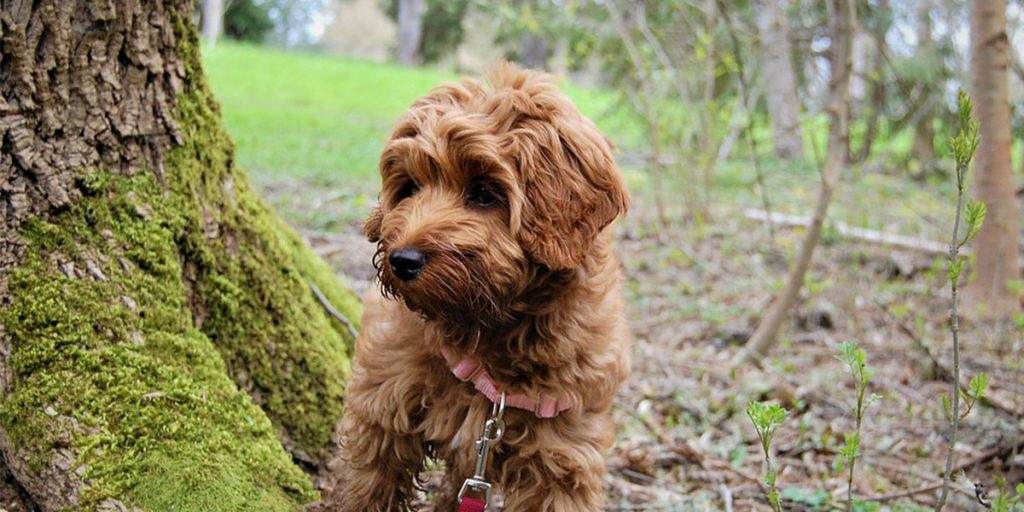
It is always beneficial to socialize your dog from an early age. Well, Mini Labradoodles are generally quite friendly with other dogs and also with new people. However, you can never predict what trait your puppy will inherit from his parents. So it is better to take them out, let them meet with new people and dogs.
Socializing and Training a dog in his puppyhood is one of the most important things. And for that, you can enroll your puppy Doodle in a Puppy Kindergarten. There will be getting and trained and will learn socializing both at the same time.
As you can already read that socializing of dog breeds that are less outgoing is necessary at an early age, especially dogs who have roots in the Doodle family.
Mini Labradoodles – Exercising and Training
Exercising
Labradoodles are a mix of two highly active and working dog breed. Hence, they will require much more exercise than other breeds.
For their exercising, the owner should participate with their dog while their dog is doing his daily physical exercise or activities. And along with that, it would be good if your dog has a backyard where they themselves can exercise and play.
In summers you can take them for swims and this can an enjoyable activity for both of you. Also, this breed is a sucker for long walks and hours of playing. So be prepared to burn lots of calories.
Because of their active personality, they will also have excess energy which can lead them into doing mischievous things, if that energy is not utilized in a good way. For doing this, you can involve your dog in physical and mental activities. Give your Doodle some interactive toys which will keep them entertained and occupied. This way their mind and body will be in the right state.
Both the Poodles and Labrador Retriever are genetically more prone to be attacked by joint conditions like Hip Dysplasia. This disease can attack any dog. However, some breed and large-sized dogs have more risk to get affected with Hip Dysplasia.
Joint Dysplasia and other health issues can be caused by canine obesity. And joint dysplasia is caused when a canine’s joints are experiencing high pressure in that area. So, with regular exercise, you can keep a check on your Labradoodle’s weight.
Adequate exercise and weight management will benefit your dog a lot. This will keep your dog active and will prevent and manage such conditions to attack your Labradoodle. But keep in mind that a dog’s joint can also be affected by under exercising or over-exercising. This will impact your dog negatively.
You can also go to a breeder who gives more attention to the puppies and ensures that the chances to inherit such conditions from the parent dogs is less. The breeder will screen both the parent dog and see if they show signs of getting affected by Hip Dysplasia.
One more disease a Labradoodle is more prone to is EIC ( Exercise-Induced Collapse). This condition occurs when a dog is exposed to intense exercises. The prevalence of EIC gets higher with the increase in temperature. Though this condition is not heat-induced. Always make sure that the outside temperature is flavorful to exercise your dog. Moreover, keep the intensity of exercise at moderate.
Training
A well behaved and friendly dog behavior is achieved by early socializing and training of the pets. These are very important things which directly influences a dog’s behavior and nature towards other peoples and animals.
There are many ways to ensure this. And one of the best ways is by introducing your dog to a puppy kindergarten. You can join your dog in these kindergartens after your dog is updated on his vaccinations. These places are fun and educative at the same time. Your dog will be properly trained under professional guidance and will learn to socialize with other dogs and people.
Dogs have the capability to learn from an early age. So it is better to start their training after they reach 8- 19 weeks age. After a dog gets older, it gets a bit difficult to control their actions. They can get stubborn which will become a hurdle in their training at that age. So the sooner the better.
Mini Labradoodles Parents – Health & Care
Mini Labradoodles are prone to inherit genetic conditions from their parents. Some of the common diseases they can get infected with are eye diseases, skin irritation, or allergies. These are commonly found ailments in the canines.
Mini Labradoodles will inherit genetic issues from his parent’s breeds. And we cannot predict which parent’s genes the puppy is going to take after. But there are some common health conditions that the Poodle and Labrador suffer from. So let’s discuss them first.
Health of Labrador Retrievers
Common concerns found in the Labrador Retrievers are dysplasia, EIC (Exercise Induced Collapse), and Progressive Retinal Atrophy. There are some joint problems and health conditions that Labradors are more prone to.
Let’s talk talk about each of the conditions in details.
Elbow and Hip Dysplasia
Labrador Retrievers have a higher tendency to get affected by Elbow and Hip Dysplasia. This condition affects the dog’s mobility and also causes a lot of pain. It occurs when there is a structural problem in the joints. Dogs of any age can get affected by this condition. Puppies that are around 4 to 6 months can also show symptoms of this disease.
This disease occurs when there is a problem in the elbow joints of the canine. Basically what happens is that a piece of cartilage or bone breaks from the joints and floats in the elbow’s joint capsule. This can lead to Osteoarthritis.
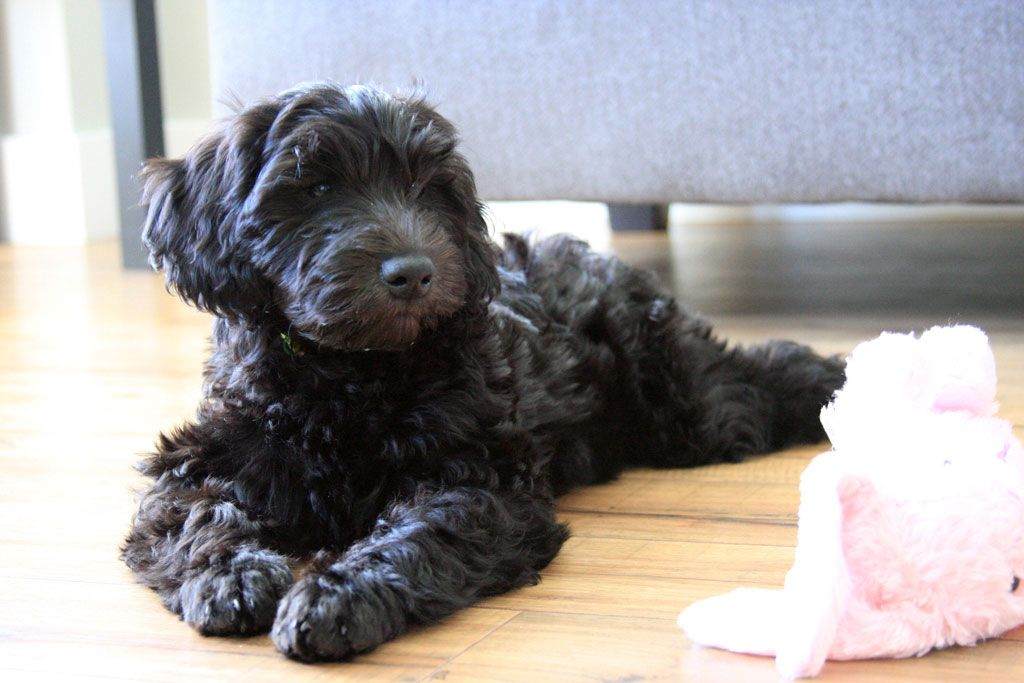
When the joints in the canine’s body do not fit properly, it leads to grinding and causes friction in the joints. As a result, a canine suffers from Hip Dysplasia. Moreover, with time this also leads to deterioration in the joint area. This disease can be a result of genetics. But other factors like obesity, immoderate growth rate, or some kinds of exercises also result in Hip Dysplasia.
Some common signs or symptoms a dog shows if he is suffering from this problem are reduced ability to climb, run or jump, looseness in a leg (affected leg), stiffness, pain, or reduced mobility.
Hip Dysplasia cannot be completely treated but there are some methods to reduce the pain and to keep the disease in control. Some of the effective treatments are weight management, surgery, specific exercises, physical therapies, and also including anti-inflammatory.
Progressive Retinal Atrophy
This is a degenerative eye disease found in dogs and it can also lead to permanent blindness. Labrador Retriever is genetically prone to PRA.
This disease shows up when a dog is around 3-9 years old and can make them completely blind in about 1 or 2 years. PRA is a painless disease. This condition is very difficult to detect when a dog is in its early stage.
Firstly the night vision of a dog is affected, which leads to night blindness. And currently, there is no solution to this disease.
Gastric Dilation
This is a life-threatening as well as very painful condition. This problem occurs when the exit path and the blood supply are cut off from the dog’s stomach. It happens when excessive food and gas are trapped in the stomach and when it rotates, it results in a painful feeling.
If a dog doesn’t receive medical help in time, the dog can die within a few hours. Some noticeable sign of this problem includes the distended stomach, panting, saliva formation, and inability in vomiting or lying down. So if you see any of these signs in your dog, immediately contact the doctor.
Cataracts
Cataracts lead to vision impairment or even blindness in dogs. And unfortunately, Labradors have a higher tendency to get affected by this problem as compared to other dog breeds. It generally occurs when the eye’s lenses get clouded.
Most probably in Labradors, this disease is genetic and it can be cured with the help of surgery. Other reasons for this disease’s occurrence can be diabetes or an eye injury.
If your dog randomly starts to bump into things or you notice a cloudy layer over his eye, take him to the vet.
EIC (Exercise Induced Collapse)
Labrador Retrievers owners are concerned about this condition too. If a dog is affected by this problem, then they will be able to handle mild or moderate level exercises. And while doing this they will appear to be fit, energetic, and healthy.
But, if they do some intensive exercises for 5-15 minutes, soon after that they will experience enormous weakness in their legs and inability to walk or move. They can even collapse with this much pressure on their body.
Symptoms can keep getting worse for about 5 minutes. However, most of the dogs recover after relaxing for 10 to 20 minutes after the condition has occurred. EIC can take about 5 years before it shows symptoms in a dog.
According to studies, EIC is a genetic condition. If the dog parents are carrying a mutated gene, only then the parents can pass on this condition to their puppy. It is also found that 30% of the Labradors are a carrier of this genetic disease. So, it is important for you to choose a breeder that has already tested the genetic mutations that the parent dogs can be carrying. Ask the breeder for a certificate or proof of this test, before you choose a puppy from them.
A responsible and reputed breeder will always conduct a DNA test to find about the heredity conditions in the dogs. However, this test cannot screen Gastric Dilation condition.
Other than the genetic conditions like EIC, PRA, or HC (Hereditary Cataract), a breeder should also conduct a screening for diseases like:
- Centronuclear Myopathy
- Hereditary Nasal Parakeratosis
- Evaluation of Hip and Elbow
Health of Mini Poodles

Similar to Labrador Retrievers, Miniature Poodles are also at high risk of getting affecting by some hereditary diseases. Some of the diseases are found both in Labradors and Poodles. And some are uniquely found only in the Poodle breed.
Both the Poodle and Labrador breed are at the same level of risk in case of inheriting diseases like Hip Dysplasia, Retinal Atrophy, and Bloating.
Here are some conditions that are more prevalent in Poodles.
Chronic Active Hepatitis
This disease causes the distinction of liver tissues and inflammation in the liver. Those dogs suffering from Chronic Active Hepatitis experiences liver failure with time.
There are no visible symptoms and signs of these diseases until 5-7 years. The symptoms include weight loss, depression, vomiting, diarrhea, and an increase in urination. You might also notice some behavioral changes in the dog like they may look confused or will just stand and stare at the door.
Though there is no permanent cure for this disease, however pet owners can control it to some extent. This condition can be detected with a blood test and if you get aware of it at an early stage, a balanced diet and proper medication will help your dog a lot.
Addison’s Disease
This is a very serious disease that affects a dog’s hormones. In this condition, a dog’s body is not able to produce a sufficient amount of adrenal hormones from its adrenal glands. You must know that these hormones are important for the sustainable life of a dog.
Poor appetite, gastrointestinal problems, lethargy are some of the signs of these conditions. A dog’s heart functionality can be affected or disturbed if he gets stressed. It can also lead to heart failure or arrhythmia.
This disease can be detected with some tests and probably a daily medication will be prescribed to treat this condition.
Patellar Luxation
This condition occurs when the patella (kneecap) gets dislocated. It can be caused by some kind of injury or by a congenital deformity.
In Mini Poodles this condition is more prevalent. Well, you can say that all miniature dog breeds are more prone to this condition.
Limping, Difficulty in knee straightening or an appearance of bow-leg are some of the signs.
The seriousness of this problem varies from dog to dog. Sometimes general treatment can cure it and other times it can require surgery.
Hypothyrodism
When the thyroid glands produce fewer hormones, Hypothyroidism condition pops up in a dog’s body.
Weight loss, skin problems, irregular heartbeat, lethargy, the problem in remaining warm and coarse texture of hair are some of the signs and symptoms of Hypothyroidism.
These diseases can be detected with a blood test and with a treatment that prescribes a daily medication will be effective.
Cushing’s Disease
Cushing’s disease occurs when there is a tumor developing in the Adrenal glands or in the brain’s pituitary gland. In either case, there is an overproduction of cortisol and alteration in hormone production.
Generally, this is an infectious tumor and can spread all over the body. But if this disease is detected at an early stage, the growth rate of the infection can be slowed down.
Potbelly, over-consumption of water and food, hair loss and change in the texture, and recurring urination are symptoms and signs of Cushing’s disease.
Hence,
Some of these health conditions are hereditary and others can be detected by good and responsible dog breeders. However, there are no genetic tests, one can rely on completely.
There are some tests that are recommended for the Mini Poodles. They are:
- PRA
- Evaluation of Patella and Hip
- VWD (Von Willebrand’s Disease)
- Epilepsy
- SA (Sebaceous Adenitis)
Mini Labradoodles – Health
Mini Labradoodles have a high chance of inheriting some general health conditions from his parent breed, i.e, Labrador Retriever, and Mini Poodle. Most probably a Mini Labradoodle inherits those health diseases that are found in both of his parents. This breed is at high risk and easily gets affected by those common health problems.
Some diseases that are commonly found in both the Parent breed are PRA (Progressive Retinal Atrophy) and Hip Dysplasia.
A good breeder will conduct a test in advance to find these diseases in his dogs. Some tests are important to be conducted on Parent dogs before breeding is done. So before taking a puppy from a breeder, ask them to show you proof of the recommended tests. Because a reputable breeder will not breed those dogs who have higher chances to inherit serious diseases from their parents.
Bloating is a condition that cannot be detected by a test and both the Parent dogs are affected by this problem. So it is important to have knowledge regarding the signs of this disease so that you can quickly take the necessary steps for this fatal condition.
Studies have shown that instead of feeding your dog once for the whole day, you should feed him smaller quantities frequently. This will effectively decrease the chances of bloating in the dog. Also, a diverse diet is said to be helpful to prevent this condition. These tips will reduce the possibility of the occurrence of this condition but it will not eliminate the risk.
Addison’s Disease, Cushing’s Disease, and Chronic Hepatitis are some conditions that Mini Labradoodles mostly inherit from his Parents. A breeder can conduct tests to find if the Parent Dog is experiencing these conditions.
One thing that you can do is to discuss with the breeder if the Parent dogs have shown any signs or any of their offspring are affected by any disease. This is crucial because there are many conditions a Mini Labradoodle can inherit from his parents.
It is very important to conduct tests at regular intervals because it will help to detect any disease in its early stage. Also, it will give a better chance to slow down the disease’s progression with treatment. Hence, book annual blood tests and health check-ups with the veterinarian to ensure your dog’s good health condition.
Life Expectancy of Miniature Labradoodles
Mixed dog breeds like Mini Labradoodles generally live a bit longer as compared to the pure dog breeds.
The average lifespan of the Labrador Retrievers is around 10-12 years. On the other hand, Mini Labradoodles lives up-to 10-18 years. The Chocolate Mini Labradoodles also vary in life expectancy.
Researches have shown that Chocolate Labradors have a high risk to get affected with ear and skin infections. And interestingly, it is also said that compared to Black and Yellow Labradors, Chocolate Labradors have a 10% decreased lifespan.
According to some theories, the strong chocolate color of a dog that is determined by the recessive genes also has a strong effect to determine the short lifespan and increased infection rate. So theoretically the life expectancy rate of a Mini Labradoodle in chocolate color is a bit lower compared to other Miniature Doodles.
Grooming of Miniature Labradoodles
Miniature Labradoodles requires some maintenance when it comes to their coat. If your dog has a double-coat then he will require a weekly brushing session from you.
But compared to the Poodles who need daily brushing, it will be easier to maintain a Mini Labradoodle’s coat.
Your dog will benefit a lot if you take him to a groomer on regular basis. Because if the Miniature Labradoodles have a longer coat, there are high chances it will get matted easily. Hence, if your dog has long hair take him to a groomer, it will make your life much easier.
Shedding of Mini Labradoodles
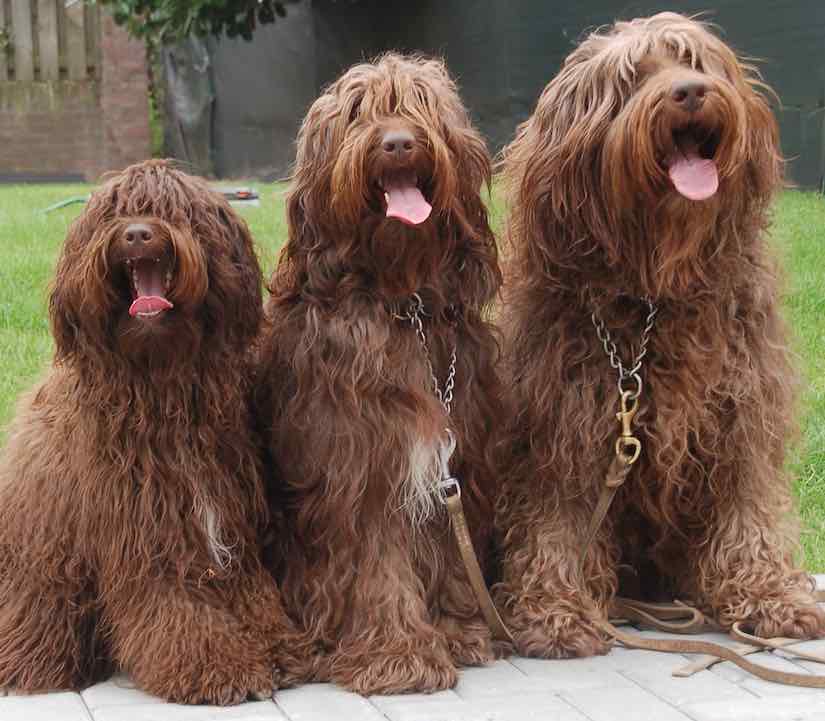
The quality of low shedding in the Poodles was the reason why it was chosen to make a service dog who was allergy-friendly.
On the other side, Labradors are heavy shredders. However, no matter what the Labradoodle inherits, their coat will probably be less shedding like their Poodle parent’s coat. But there is also a slight chance that their coat ends up resembling more to a Labrador’s shaggier coat. Here you will get a coat that will shed averagely, means not more not less.
Are Mini Labradoodles Good Family Dogs?
Miniature Labradoodles are great with families and other animals too. They are very friendly with children and have a nice temperament. Because they are very energetic, it would be suitable for them to go into a family with older children as they can unknowingly harm a small child by jumping on them.
You cannot expect a toddler or a small kid to handle such an energetic dog and play with them all the time. So, it would be better to have Mini Labradoodles if your kids are old enough.
Some Pros and Cons
There are some pros and some cons of having a dog as your pet.
Let’s talk about some pros of having a Mini Labradoodle as a pet.
- They are very affectionate, friendly, and playful in nature. They are good for children and other pets.
- Also very intelligent and you can train them easily.
- For active families, they are the best companion because they are always full of energy.
Now some cons.
- Because they are very energetic, you will need to take them for walks and make them exercise daily.
- They will require a bigger space for playing and running.
- Regular maintenance of their coat and trips to the groomer is required.
- Can be sometimes much more energetic than required.
- Possibility of inheriting some genetic diseases.
In a mixed breed dog, it is impossible to completely predict what kind of traits a puppy will inherit. For instance, a dog’s size, coat’s texture of shedding, or his potential health is not fixed.
But there is a rough picture which you can use to decide if a Mini Labradoodle is suitable for you or not. If you are okay to live with an energetic buddy and can provide him with sufficient attention and space for his daily activities, Mini Labradoodles is the answer for you. These little creatures are a little bundle of joy and they will make a good companion to you.
Table of Contents

